 |
| by Maria do Rosário de Almeida Braga |
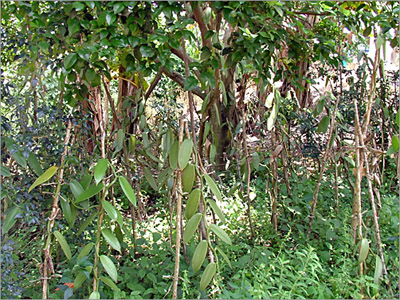 |
Vanilla planifolia is an orchid species that grows like a vine
and is native of Mexico. From the dry fruits of V. planifolia,
vanillin is extracted. It is responsible for the very well known taste
of vanilla. The species is one of around 100 species in the genus Vanilla (subfamily Epidendroide), which has a pan-tropical distribution. Thirty one species are listed for Brazil (Pabst & Dungs, 1975) but none of them is commercially exploited. Although V. planifolia is the main species that produces vanillin, V. tahitiensis and V. pompona are also cultivated with this purpose (Sheehan & Farace, 2003). |
During a recent trip to Mexico I had the opportunity to visit the town
of Papantla, in the State of Vera Cruz, three hours away from México
D.F. by car. Papantla, at an altitude of 60m, is in the center of the Mexican region that produces Vanilla. Another four or five municipalities comprise the region of Vanilla production. In Papantla the annual temperature ranges from 20 to 40ºC and the rainfall is 1600mm per year, Summer being the rainy season. Even today Vanilla planifolia germinates easily among the local vegetation (S.N. Corona, pers. com.) Since the first written references, in the 16th century, about the customs of the Aztecs and the plants that were used in Mesoamerica when the Spanish arrived, there is mention of “tlilxochitl” (black flower) as one of the flavors added to the drink they use to make from cacao (Coe & Coe, 2000). “Black flower” is how the Totonacs called the fruit of Vanilla, which, after it dries, turns dark brown or black. The Totonacs, who lived in the area even before the Aztec’s dominion (1.200-1.500aC), have been practicing agriculture for many centuries. Other agriculture cultures have also lived in the region. The archaeological site of “El Tajin” is located 20 km from the town of Papantla. It was built between 300 and 1100aC by the Huastecs. |
“Temple
of the Niches” decorated with 365 niches, each of them representing
a day of the agriculture cycle, showing the importance of agriculture
for them. Among the images sculptured on the external walls of the temple,
one refers to a ritual with cacao. Nowadays it is known that in Veracruz agriculture started around 1000bC (Wilkerson, 1980) and Vanilla planifolia has been among the cultivated products for centuries. |
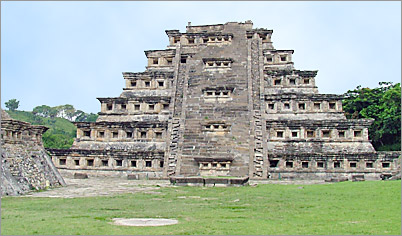 |
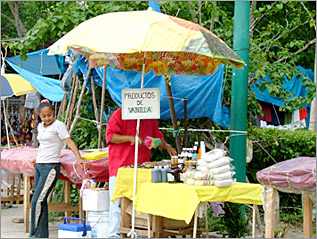 |
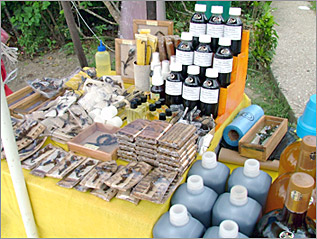 |
Besides
their culinary use, the fruits of Vanilla are also used for making
handcraft by the local people. Up until a few years ago these handcraft products were very popular in the streets of Papantla. However the strong floods of a few years ago caused a steep decrease in the local production. Most of what is produced in the region these days is exported. Only the fruits that are not approved in quality tests are used for handcraft that can still be found in touristic sites |
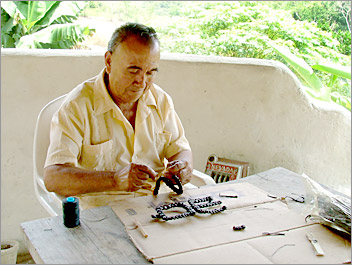 |
Nowadays
Mexico is no longer the largest producer of Vanilla and not many
families still base their economy exclusively on this crop. During my visit I was lucky to be welcomed by a family who have been cultivating, processing and exporting “vainilla” for many generations. The V. planifolia vines grow supported by bamboo poles, protected from full sun by the half shade of banana trees or other trees. The flowers open between April and May and, to increase the production, the flowers are now hand pollinated. |
In
general, from 12 flowers pollinated per inflorescence, only six fruits
are selected in order for them to grow better. The long, thin fruits grow until they reach 18-22 cm in length. They are harvested in December, at the beginning of Mexican Winter. From then on the processing of the fruits starts and it lasts three months. During this period thousand of fruits are spread outdoors every day, in order for them to dry under the sun. Every afternoon they are collected and wrapped with blankets and stored in big wooden boxes. After this period the fruits are manually selected and carefully cleaned. |
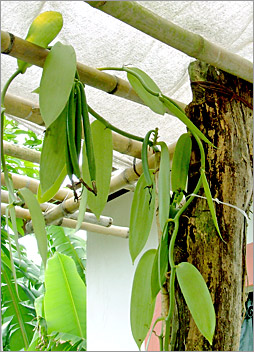 |
| Seven kilograms of fruits harvested correspond to 1kg of dried fruits. After being packed they are ready to be exported |
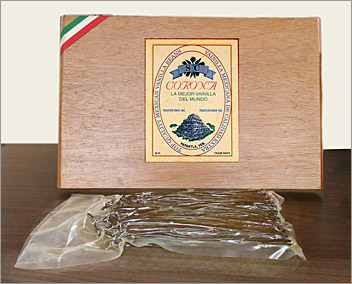 |
A
small percentage is eventually sold to the Mexican market as whole fruits.
The price of Vanilla in the international market varies a lot according to the availability and quality of the product. In 2003 and 2004 the price has varied from US$95 / kg to US$475 / kg. |
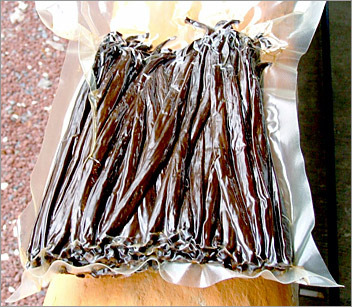 |
Mexican
Vanilla producers fertilize the soil where V. planifolia is planted
only with organic fertilizer. The insecticide that is most used against
possible pests is a mixture of papaya extract and soap. Bacteria can
kill part of the plant’s tissue and they are considered to be
the largest danger to the plantations. Bibliographic References: - Pabst,
G. and F. Dungs. 1975. Orchidaceae Brasiliensis. Vol.1. Hildesheim,
Brücke Verlag. 408pp. |
|